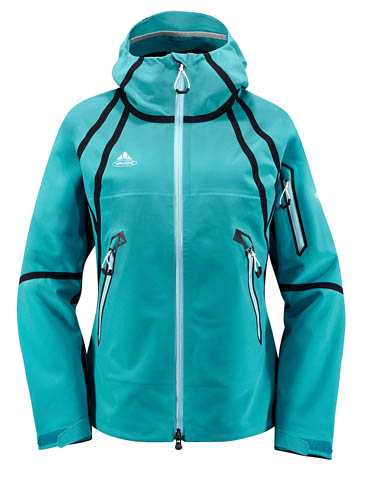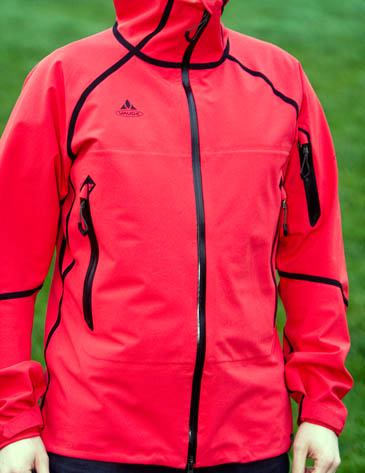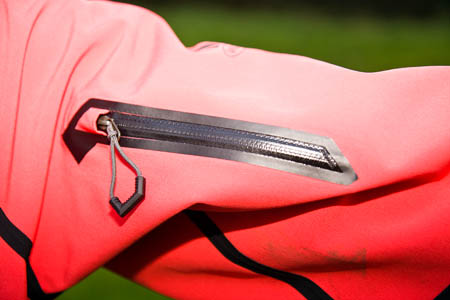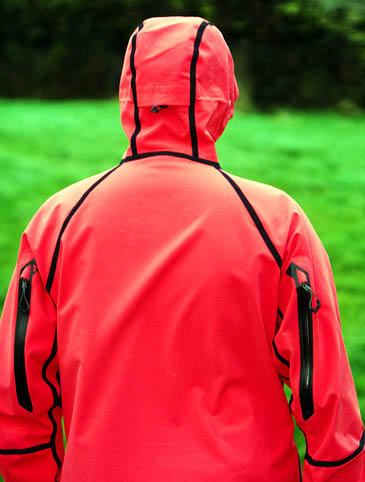
The women's Alpamayo
Vaude Alpamayo jacket
Typical price: £370
Weight: 713g
Material: polyethylene/Elastene softshell with NeoShell membrane and polyethylene fleece lining
Country of manufacture: China
The Vaude Alpamayo cuts a different look on the hills.
It’s one of the few jackets to use Polartec’s NeoShell fabric, which was launched just over a year ago with some bold claims about waterproofness and breathability.
The men’s Alpamayo loaned to grough by Vaude came in bright red and, at first glance passers-by might be forgiven for thinking you are wearing it inside-out.
The black ultrasonically welded seams on the exterior contrast nicely and match the black of the main water-resistant zip and those of the pockets and vents.
Vaude classes the Alpamayo as a softshell and its fabric doesn’t have that hardshell rustle. But unlike many softshell garments, this is a waterproof. Vaude and Polartec say it resists water to the industry-standard 10,000mm hydrostatic head.
We didn’t fancy standing under 10m of water but we did give the Alpamayo a good run-out in some very varied conditions.
The jacket performed well, keeping out the wind in sub-zero temperatures on a hillwalking trip. There was very little evidence of sweat when pushing hard uphill in cold, clear conditions.
In the wet, the Alpamayo kept out some pretty heavy rain encountered in driving wind.
The jacket is a minimalist design and there are no storm flaps over the zips. A worry with water-resistant zips is that the flexing of the material lets in some rain in use, but we did not encounter this over our extended test period.
The only zip niggle was that the main two-way zip became stiff to engage when fastening – annoying when you need to zip up in a rush to keep out the rain. Once the slider had passed the bottom centimetre or so of the zip it slid fine, but on such an expensive jacket it was disappointing and slightly worrying that this vital element of the jacket was difficult to use and might not stay the course.
The fabric of the Alpamayo is thicker than many lightweight waterproofs but keeping things minimalist has enabled the weight, quoted by the manufacturer, to be kept to 713g. Don’t expect to fold the jacket into a tiny pouch, however.
The outer fabric feels tough; it’s 84 per cent polyethylene and 16 per cent Elastene, which gives it a slight two-way stretch which is useful when reaching for handholds or just clambering over stiles.
Its lining is a black, thin fleecy material, which helps with warmth though this is not an insulating garment. You’ll still need to layer up on cold days. Pockets, of which there are two on the chest – just big enough to fit in a laminated OS map – are mesh lined.
There is a small inside pocket, large enough to fit a smartphone or handheld GPS, and on the left sleeve is a tiny pocket that is an insight into part of the market the Alpamayo is aimed at: it will fit your ski pass and nothing much bigger, possibly a compass.
The hem can be cinched via its drawcord which adjusts through the main pockets and there are Velcro cuffs on the sleeves.
The hood has a single adjustment via a combined volume adjuster and side drawcords. This is via a pullcord at the back of the hood. A nice design touch from the jacket’s creators Johan Räihä & Sinja Witte is the little rain cowl which protects the cord, but this does mean it is fiddly to get at in thick gloves.
As with many modern thin shockcords, the spring-loaded adjuster struggles to grip it well, and in windy conditions the cord has a tendency to slacken. Our solution was to pre-tie a knot in the cord at the desired spot.
The little cowls also protect the top end of the zips on both the little sleeve pocket and the unusual vents.
Vaude has eschewed the traditional pitzips and placed the zipped vents on the outside face of the upper sleeve, facing backwards. This undoubtedly lets in more air than the conventional placing and works well if walking into the wind, but in their exposed position on the outside of the arms, there’s a risk of driven rain getting in if the gale is on your back.
The German brand’s new jacket oozes quality. There are nice touches all over and the construction feels very good. The zip pullers are well thought-out, with loops and a plastic tab making them very easy to use with gloves on.
The design is very European and no worse for that. It’s a striking jacket that we liked wearing. It stood up to abrasion on a few scrambly routes and felt like it should last a long time, which is why that zip problem was such a disappointment.
One other niggle: the labels in the inside pocket jammed the zip at one point, which meant we couldn’t open it without taking it off and using a bit of force to extricate the labels from the zip’s teeth. If we had been in a critical situation on the mountain this could have been more than an annoyance. A thought on repositioning those labels might be due.
By the end of our tests, the fabric was still beading rain nicely in most places. Vaude recommends using standard Nikwax products to wash and reproof the jacket.
So how did the new NeoShell membrane perform? Polartec claims an increase in breathability of 100 per cent over conventional waterproof membranes.
In a very unscientific assessment, we would bear this out. There was about half the amount of sweat that we would normally expect inside the jacket after a protracted day out on the hills in rainy conditions. In dry conditions using the coat as a windproof, there was even less.
Compared to the conventional membrane waterproof trousers we were wearing, at the end of the day the Alpamayo felt decidedly less damp inside. A welcome feeling. Combined with the thin fleece lining, as part of a layered system, the NeoShell jacket worked well.
The jacket comes in both men’s and women’s versions, the men’s in red or black, sizes S to XXXL; the women’s in Capri blue or black, sizes XXS to XL. We found the jacket tended to the snug side of the norm.
We liked:
Breathability
Style
Quality
We weren’t as keen on:
Price
Hood
Zip problems


